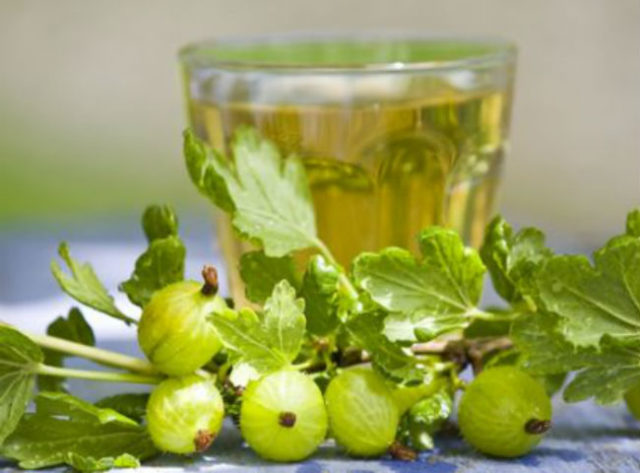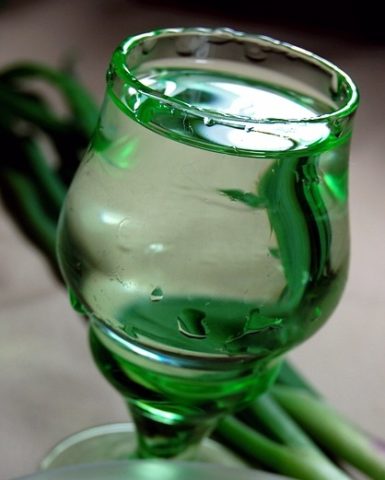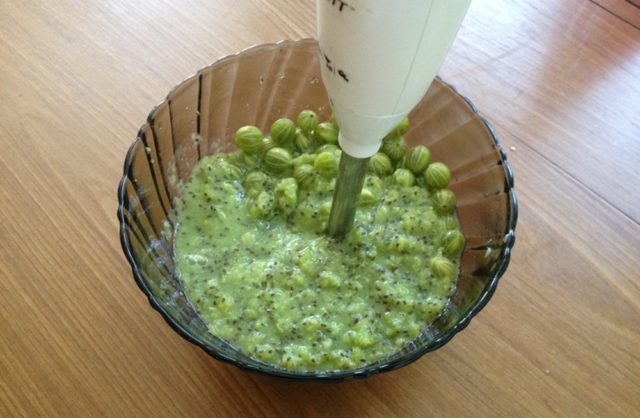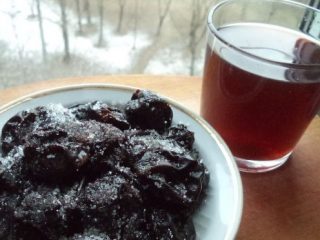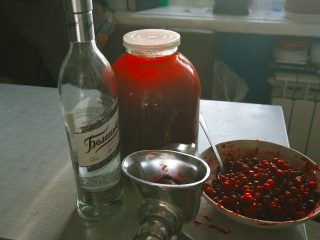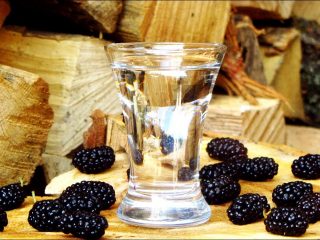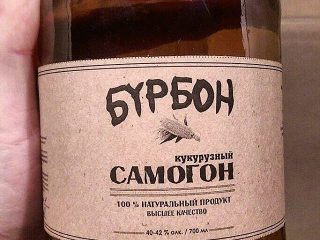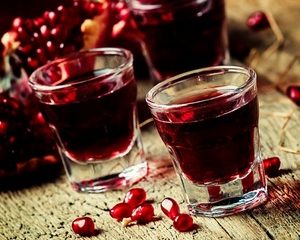Content
- 1 Features of preparing moonshine from gooseberries
- 2 How to make mash from gooseberries
- 3 Classic gooseberry moonshine recipe
- 4 Gooseberry moonshine with yeast
- 5 How to make moonshine with gooseberries without yeast
- 6 Gooseberry and strawberry moonshine recipe
- 7 Gooseberry moonshine with lemon
- 8 Gooseberry moonshine with sugar syrup
- 9 Distillation and purification of gooseberry moonshine
- 10 Storage rules
- 11 Conclusion
Moonshine at home can be prepared from many natural products. Often fruits or berries are used for it, which can be found in unlimited quantities in the summer. Homemade gooseberry moonshine can turn out to be both a tasty and profitable drink if you manage to become the happy owner of a large number of berries.
Features of preparing moonshine from gooseberries
There are many varieties of gooseberries. And not all of them bear fruit at the same time. There are earlier and later ones. But in a fully ripe state, the berries of almost any variety of gooseberry contain quite a lot of sugar. However, it is determined not only by varietal characteristics, but also by the region of growth, as well as the weather conditions of the current summer season. Depending on all these conditions, the sugar content of gooseberries can range from 9 to 15%.
These figures indicate that from 1 kg of raw berries you can get from 100 to 165 ml of pure homemade moonshine with a strength of approximately 40%.And this is without added sugar or any additional ingredients. When using only berries and water.
For some this may not seem enough. But even here there is a well-known solution to the problem - add sugar to the mash. This will help to significantly increase the yield of the finished product. After all, adding only 1 kg of sugar increases the volume of the finished 40% moonshine by 1-1.2 liters. But a significant part of the aroma inherent in a drink made from just gooseberries will definitely be lost. So there is always a choice and it remains with those who make gooseberry moonshine at home for their various needs.
As already mentioned, you can use any type of gooseberry to make moonshine. But their quality needs special attention. You cannot use spoiled or rotten berries, especially those that have traces of mold. Even a few rotten berries that accidentally fall into the mash can cause, at best, completely unnecessary bitterness in the finished drink. In addition, the more ripe the gooseberries are, the better. They will yield a greater yield of pure homemade moonshine.
When making moonshine at home, ordinary water is required. And special mention should be made about it, since the characteristics of the fermentation process depend on its quality and temperature.
It is best to use spring or spring water, but not everyone has this opportunity. Do not boil water or use distilled liquid. They do not have the properties of “living” water and it will be difficult for yeast bacteria to multiply in such an environment. As a result, fermentation may slow down greatly or stop altogether.
The easiest way is to use tap water, standing for 24 hours and passing through a special filter to remove unwanted components. The water should also not be cold. The most favorable temperature for fermentation is water temperature ranging from + 23 C to + 28 ° C.
To make gooseberry mash for further distillation, you can use different types of yeast. Sometimes mash is made without yeast at all, and wild yeast living on the surface of unwashed berries is responsible for the fermentation process. Adding artificial yeast can significantly speed up the mash making process. But this will definitely affect the taste and aroma of the finished homemade moonshine, and not for the better.
In general, there are only three types of additional yeast for making mash:
- dry bakery products;
- fresh pressed;
- alcohol or wine.
The first option is the most accessible and inexpensive. In addition, they can be stored for quite a long time in a regular refrigerator. They require activation before use, but their action is stable and predictable.
Pressed yeast usually works even faster than dry yeast and is also easy to find on sale. But they do not last long in the refrigerator, and their effect if stored incorrectly may be different from what was expected.
Wine or alcoholic ones are the most suitable option for making mash, since they ferment the fastest and have the least effect on the taste and aroma. But they are sold only in specialized stores and their cost is incomparably higher than that of ordinary yeast.
How to make mash from gooseberries
To make mash from gooseberries you will need:
- 5 kg gooseberries;
- 1 kg sugar;
- 7 liters of water;
- 100 g pressed fresh or 20 g dry yeast.
Manufacturing:
- Gooseberries are sorted, removing spoiled berries, washed and chopped using any convenient device (blender, food processor, meat grinder, knife).
- Add sugar, mix well and leave for 3-4 hours to obtain the most homogeneous mixture.
- Then the resulting mixture is placed in a special fermentation container of a fairly large volume so that after adding water there is still about 1/3 of free space. This could be, for example, a 10-liter glass jar.
- Warm purified water and yeast are also added there.
- Stir and install any suitable water seal on the neck. You can also use a regular new medical glove with one of the fingers pierced with a needle.
- Transfer the fermentation container to a warm place (+ 20-26 °C) without light.
- The fermentation process with the addition of yeast usually lasts from 4 to 10 days.
When the process is complete they will say:
- a deflated glove or water seal will stop releasing bubbles;
- a noticeable sediment will appear at the bottom;
- All the sweetness will go away, and the mash will be barely noticeably bitter.
At the last stage, the finished mash is filtered through several layers of gauze or cloth so that not the slightest piece of skin or pulp remains, which can burn during distillation.
Classic gooseberry moonshine recipe
The previous chapter described the recipe for the classic preparation of homemade moonshine with gooseberries. After the mash has completely fermented, all that remains is to distill it through a moonshine still.
To avoid additional purification, it is better to use double distillation.
- The first time the mash is distilled without separating the heads, until the strength is reduced to 30%.Comment! The moonshine may remain cloudy; this is normal.
- Then the strength of the resulting distillate is measured in order to determine the amount of pure alcohol contained in the moonshine. To do this, the entire resulting volume of moonshine is multiplied by the strength percentage, and then divided by 100.
- Add enough water to the moonshine so that the final strength becomes 20%.
- They make a second distillation of the resulting drink, but it is mandatory to separate the “heads” (the first 8-15%) and the “tails” (when the strength begins to fall below 45%).
- The resulting moonshine is again diluted with water to a final strength of 40-45%.
- So that the water has time to mix well with the distillate, before drinking, the moonshine is infused in a dark place at a cool temperature for several days.
Gooseberry moonshine with yeast
Using all the technology described above, you can prepare homemade moonshine from gooseberries with yeast, but without adding sugar. Only for this recipe you need to take the ripest and sweetest berries.
You will need:
- 5 kg gooseberries;
- 3 liters of water;
- 100 g fresh yeast.
The entire procedure for making mash and further distillation remains absolutely similar to that described above. Only after crushing the berries do not need to be infused, but you can immediately add yeast and water and place them in a container under a water seal.
As a result, from the above ingredients you can get about 800-900 ml of aromatic homemade moonshine, 45% strength with an interesting herbaceous flavor.
How to make moonshine with gooseberries without yeast
If you want to get the most natural drink without the slightest foreign impurities in the aroma or taste, then use only:
- 5 kg gooseberries;
- 3 liters of water.
A peculiarity of making mash for moonshine in this case is the use of unwashed gooseberries. This is important because fermentation will occur only due to wild yeast living on the surface of the berries. And the fermentation process itself will be extended for at least 20-30 days, and may take all 50. But the taste and aroma properties of the resulting moonshine can pleasantly surprise even a specialist.
Gooseberry and strawberry moonshine recipe
Adding strawberries will help give homemade gooseberry moonshine softness and an additional berry aroma.
You will need:
- 3 kg gooseberries;
- 2 kg strawberries;
- 1 kg sugar;
- 7 liters of water.
The procedure for making mash and distillation is similar to that described in the classic recipe. The result will be about 2 liters of moonshine with a strength of 45% with a pleasant aroma.
Gooseberry moonshine with lemon
Lemon has long been famous for its taste and cleansing properties. If you add gooseberry mash with the addition of lemon, this will help give homemade moonshine an attractive aroma and additionally cleanse it of unnecessary impurities.
You will need:
- 3 kg of ripe gooseberries;
- 2 lemons;
- 10 glasses of sugar;
- 5 liters of water.
Manufacturing:
- Gooseberries are sorted, crushed, mixed with 3 cups of sugar and left for a couple of hours in a warm place.
- Then they are placed in a fermentation container, water is added and placed under a water seal for about 10 days.
- After 10 days, the lemons are doused with boiling water and cut into slices, removing the seeds.
- Mix with the remaining amount of sugar according to the recipe.
- Add to the fermentation tank and reinstall the water seal.
- After the end of fermentation, which can happen in another 30-40 days, the resulting mash is drained from the sediment and, strained through cheesecloth, squeezed thoroughly.
- Distilled using the technology described above and get about 2.5 liters of fragrant homemade moonshine with a citrus aroma.
Gooseberry moonshine with sugar syrup
You will need:
- 3 kg of gooseberries;
- 2250 ml water;
- 750 g granulated sugar.
Manufacturing:
- First prepare sugar syrup. Mix water with sugar and boil it until a completely homogeneous consistency is obtained.
- Cool and mix with grated unwashed gooseberries.
- Place the mixture in a fermentation container, install a water seal and place it in a warm place. For the first 3-5 days, stir the liquid daily with a wooden spoon or clean hand.
- Then filter, squeezing out all the pulp.
- The remaining juice is again left to ferment in a warm place without light under a water seal.
- After fermentation is complete, the juice is filtered again and distilled to produce moonshine at home using already known technology.
Distillation and purification of gooseberry moonshine
The entire distillation process has already been described in detail above. If everything was done according to the described technology with the separation of the “heads” and “tails,” then the resulting gooseberry moonshine does not need additional purification.
Storage rules
Gooseberry moonshine should always be stored in glass containers with hermetically sealed lids. The temperature can vary from + 5 °C to + 20 °C, but more important is the absence of light in the storage area.
Under the right conditions, homemade moonshine can be stored for 3 to 10 years.
Conclusion
Making homemade moonshine from gooseberries is not too difficult if you have the appropriate utensils and equipment. This drink can be beneficial especially when there is a large amount of ripe berries that have nowhere else to use.
